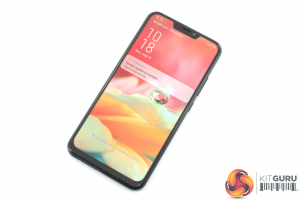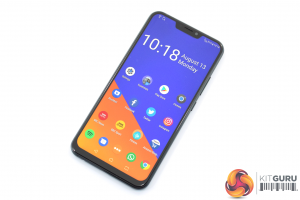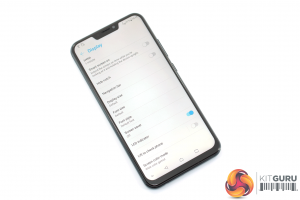Design
Note: if the above images are not displaying properly, you may need to disable your ad block software as they are known to interfere with our display code.
If you have been keeping up to date with the smartphone market over the last year, then you will be instantly familiar with the look of the ZenFone 5. That's because – like almost everyone else – the company has shrunk the bezels, added a notch and removed the front-facing fingerprint scanner. Compared to the ZenFone 4, this new look is admittedly a huge leap forward – but compared to the rest of the market, it is nothing new.
Still, it is good to see a much larger 6.2in display with the ZenFone 5, as that is 0.7in bigger than its predecessor's screen. The notch is a bit larger than most – though it is still smaller than the iPhone X's – but you can ‘disable' it using software. As the screen is IPS LCD not OLED, however, you can very much tell it is still there.
In terms of the device colour, the ZenFone 5 is available in two options – midnight blue or meteor silver. I have the former, and I have to say it looks much more grey in person – the official product photos make it look almost black which is certainly not the case. That aside, the glass back does shimmer when it hits the light in a certain way, and you can see the effect it has in the images above – light seems to burst out from around the fingerprint scanner, and it is certainly an attractive touch.
Elsewhere, a power button and volume rocker are found on the right-hand edge of the phone, while the SIM tray (which supports dual nano-SIMs or 1x SIM and 1x microSD card) is situated on left-hand edge. At the bottom edge we find the USB-C port, speaker grille and a 3.5mm jack. On the back of the phone, a circular fingerprint scanner is positioned towards to the top of the device, but it is within easy reach of your index finger. A small module in the top-left corner houses the dual-camera system.
Lastly, it is definitely worth noting there is no IP rating for water and dust resistance, and ASUS does not even claim that the phone is ‘splash proof' – a tactic employed by the OnePlus 6, despite that phone lacking an IP certification as well. I would definitely avoid getting this phone wet at all costs.
Display
Like the vast majority of other smartphones these days, the ZenFone 5 has adopted a taller screen aspect ratio – 18.7:9, to be exact, This means the resolution is the so-called ‘Full HD+', or 2246×1080.
Across the 6.2in display, this gives a pixel density of 402 PPI – roughly in-line with the Honor 10 and even the Huawei P20 Pro. It is not as razor-sharp as QHD displays – with the Note 9, for instance, you can't make out the individual pixels – but for the price, it is certainly sharp enough.
It's also an IPS panel – which is about as good as it gets for this price, as it would be a minor miracle to get an OLED display for £350. Still, colours are punchy out of the box and viewing angles are similarly excellent. If you want to tinker with the overall look of the display, too, there are options to adjust the saturation levels and white balance in the phone's settings.
Lastly, brightness levels are also good. The phone gets bright enough to use outdoors on a sunny day, while it does get just about dim enough to use comfortably in a dark room. Overall, it is a very capable IPS display for the money.
 KitGuru KitGuru.net – Tech News | Hardware News | Hardware Reviews | IOS | Mobile | Gaming | Graphics Cards
KitGuru KitGuru.net – Tech News | Hardware News | Hardware Reviews | IOS | Mobile | Gaming | Graphics Cards














